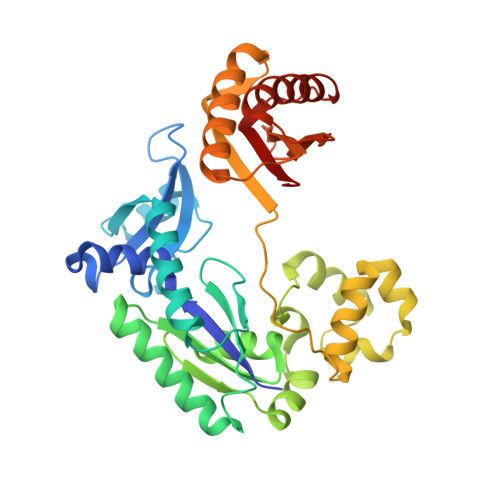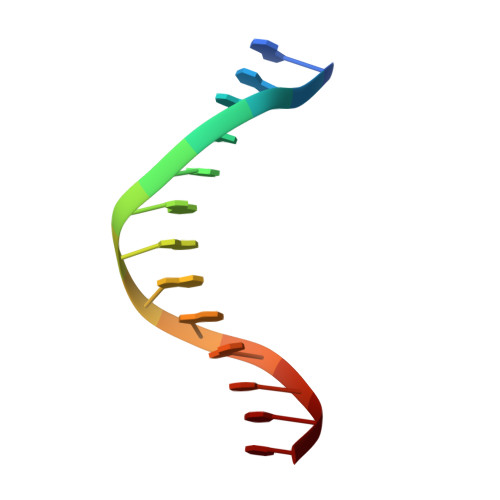Bypass of Aflatoxin B(1) Adducts by the Sulfolobus solfataricus DNA Polymerase IV.
Banerjee, S., Brown, K.L., Egli, M., Stone, M.P.(2011) J Am Chem Soc 133: 12556-12568
- PubMed: 21790157
- DOI: https://doi.org/10.1021/ja2015668
- Primary Citation of Related Structures:
3PVX, 3PW0, 3PW2, 3PW4, 3PW5, 3PW7 - PubMed Abstract:
Aflatoxin B(1) (AFB(1)) is oxidized to an epoxide in vivo, which forms an N7-dG DNA adduct (AFB(1)-N7-dG). The AFB(1)-N7-dG can rearrange to a formamidopyrimidine (AFB(1)-FAPY) derivative. Both AFB(1)-N7-dG and the ¦Â-anomer of the AFB(1)-FAPY adduct yield G¡úT transversions in Escherichia coli, but the latter is more mutagenic. We show that the Sulfolobus solfataricus P2 DNA polymerase IV (Dpo4) bypasses AFB(1)-N7-dG in an error-free manner but conducts error-prone replication past the AFB(1)-FAPY adduct, including misinsertion of dATP, consistent with the G¡úT mutations observed in E. coli. Three ternary (Dpo4-DNA-dNTP) structures with AFB(1)-N7-dG adducted template:primers have been solved. These demonstrate insertion of dCTP opposite the AFB(1)-N7-dG adduct, and correct vs incorrect insertion of dATP vs dTTP opposite the 5'-template neighbor dT from a primed AFB(1)-N7-dG:dC pair. The insertion of dTTP reveals hydrogen bonding between the template N3 imino proton and the O(2) oxygen of dTTP, and between the template T O(4) oxygen and the N3 imino proton of dTTP, perhaps explaining why this polymerase does not efficiently catalyze phosphodiester bond formation from this mispair. The AFB(1)-N7-dG maintains the 5'-intercalation of the AFB(1) moiety observed in DNA. The bond between N7-dG and C8 of the AFB(1) moiety remains in plane with the alkylated guanine, creating a 16¡ã inclination of the AFB(1) moiety with respect to the guanine. A binary (Dpo4-DNA) structure with an AFB(1)-FAPY adducted template:primer also maintains 5'-intercalation of the AFB(1) moiety. The ¦Â-deoxyribose anomer is observed. Rotation about the FAPY C5-N(5) bond orients the bond between N(5) and C8 of the AFB(1) moiety out of plane in the 5'-direction, with respect to the FAPY base. The formamide group extends in the 3'-direction. This improves stacking of the AFB(1) moiety above the 5'-face of the FAPY base, as compared to the AFB(1)-N7-dG adduct. Ternary structures with AFB(1)-¦Â-FAPY adducted template:primers show correct vs incorrect insertion of dATP vs dTTP opposite the 5'-template neighbor dT from a primed AFB(1)-¦Â-FAPY:dC pair. For dATP, the oxygen atom of the FAPY formamide group participates in a water-mediated hydrogen bond with Arg332. The insertion of dTTP yields a structure similar to that observed for the AFB(1)-N7-dG adduct. The differential accommodation of these AFB(1) adducts within the active site may, in part, modulate lesion bypass.
Organizational Affiliation:
Department of Chemistry, Center in Molecular Toxicology, Vanderbilt Institute of Chemical Biology, Vanderbilt University, Nashville, Tennessee 37235, United States.

















